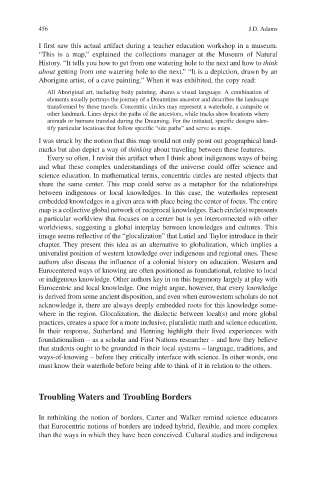Page 481 - Cultural Studies of Science Education
P. 481
456 J.D. Adams
I first saw this actual artifact during a teacher education workshop in a museum.
“This is a map,” explained the collections manager at the Museum of Natural
History. “It tells you how to get from one watering hole to the next and how to think
about getting from one watering hole to the next.” “It is a depiction, drawn by an
Aborigine artist, of a cave painting.” When it was exhibited, the copy read:
All Aboriginal art, including body painting, shares a visual language. A combination of
elements usually portrays the journey of a Dreamtime ancestor and describes the landscape
transformed by these travels. Concentric circles may represent a waterhole, a campsite or
other landmark. Lines depict the paths of the ancestors, while tracks show locations where
animals or humans traveled during the Dreaming. For the initiated, specific designs iden-
tify particular locations that follow specific “site paths” and serve as maps.
I was struck by the notion that this map would not only point out geographical land-
marks but also depict a way of thinking about traveling between these features.
Every so often, I revisit this artifact when I think about indigenous ways of being
and what these complex understandings of the universe could offer science and
science education. In mathematical terms, concentric circles are nested objects that
share the same center. This map could serve as a metaphor for the relationships
between indigenous or local knowledges. In this case, the waterholes represent
embedded knowledges in a given area with place being the center of focus. The entire
map is a collective global network of reciprocal knowledges. Each circle(s) represents
a particular worldview that focuses on a center but is yet interconnected with other
worldviews, suggesting a global interplay between knowledges and cultures. This
image seems reflective of the “glocalization” that Lutiel and Taylor introduce in their
chapter. They present this idea as an alternative to globalization, which implies a
univeralist position of western knowledge over indigenous and regional ones. These
authors also discuss the influence of a colonial history on education. Western and
Eurocentered ways of knowing are often positioned as foundational, relative to local
or indigenous knowledge. Other authors key in on this hegemony largely at play with
Eurocentric and local knowledge. One might argue, however, that every knowledge
is derived from some ancient disposition, and even when eurowestern scholars do not
acknowledge it, there are always deeply embedded roots for this knowledge some-
where in the region. Glocalization, the dialectic between local(s) and more global
practices, creates a space for a more inclusive, pluralistic math and science education.
In their response, Sutherland and Henning highlight their lived experiences with
foundationalism – as a scholar and First Nations researcher – and how they believe
that students ought to be grounded in their local systems – language, traditions, and
ways-of-knowing – before they critically interface with science. In other words, one
must know their waterhole before being able to think of it in relation to the others.
Troubling Waters and Troubling Borders
In rethinking the notion of borders, Carter and Walker remind science educators
that Eurocentric notions of borders are indeed hybrid, flexible, and more complex
than the ways in which they have been conceived. Cultural studies and indigenous

